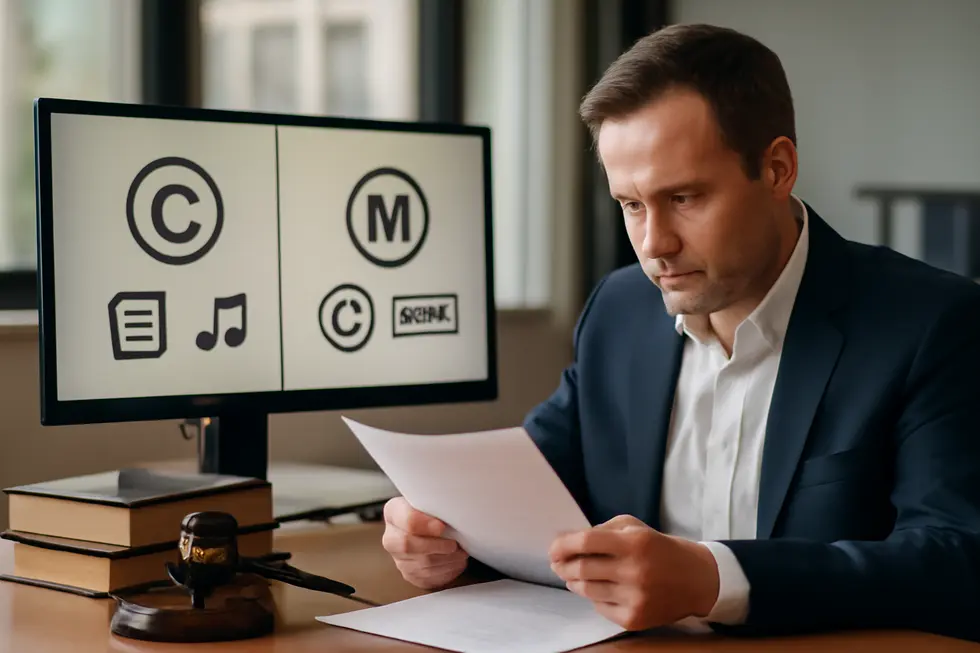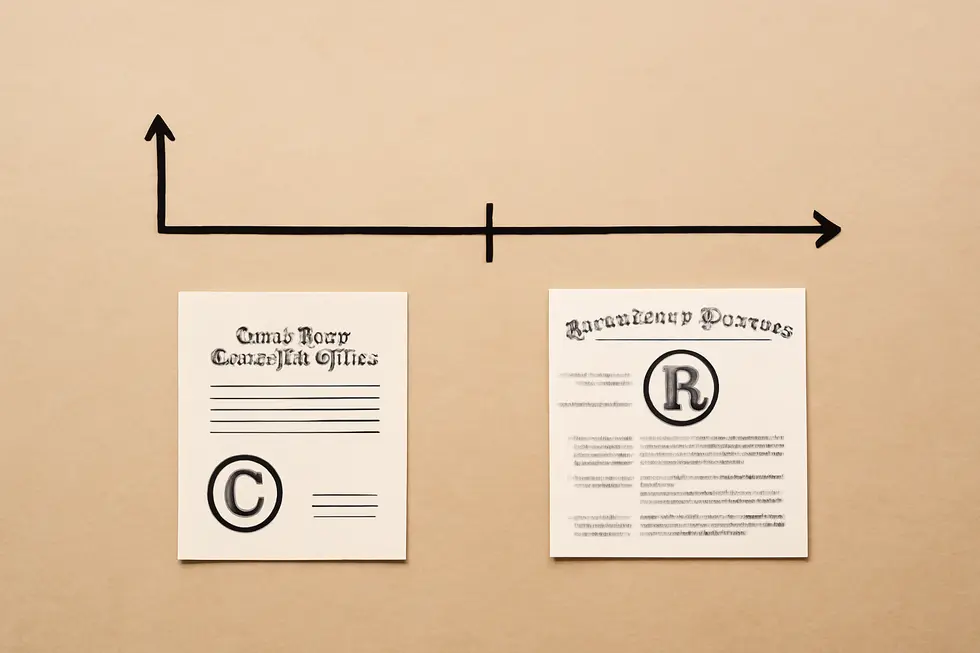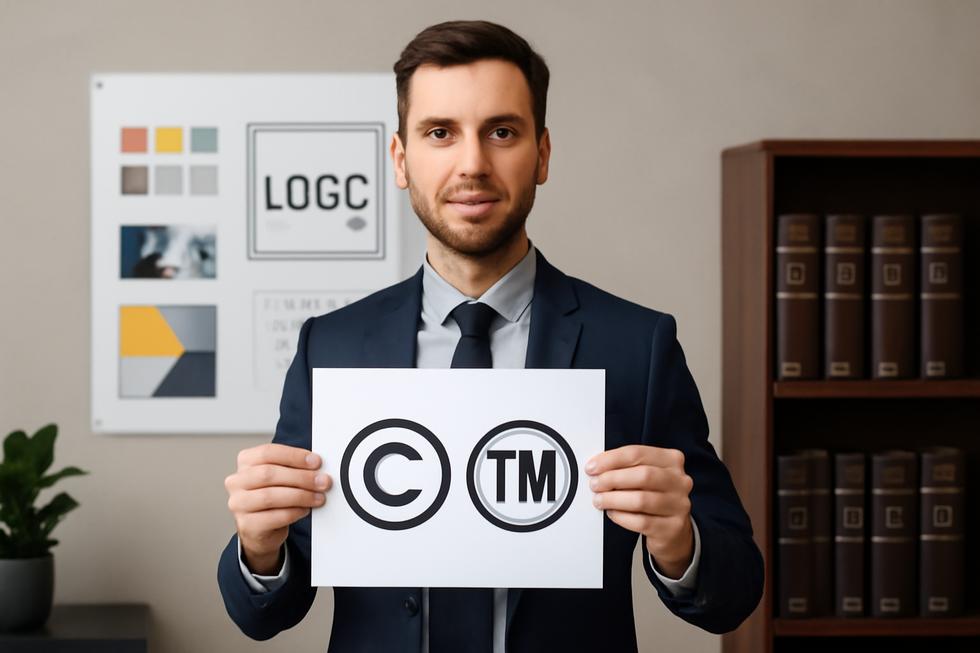Introduction
Understanding the distinctions and applications of copyright and trademark law is vital for business owners seeking to protect their creative assets and brand identity. Both frameworks offer crucial legal protections but serve different purposes within intellectual property law. This article provides a comprehensive overview, starting with foundational definitions and scope to clarify what each law covers. Subsequent chapters delve into key legal differences, the specific protections afforded by each law, and the nuances of their duration and registration requirements. We then explore how enforcement and legal proceedings operate to safeguard your rights. Finally, practical strategies for leveraging copyright and trademark protections in various business contexts will equip you with actionable knowledge to strengthen your competitive position. By weaving these elements together, this guide aims to empower you with a clear and actionable understanding of copyright and trademark law tailored to your business needs.
Tables of Contents
Chapter 1: Fundamentals of Copyright and Trademark Law: Definitions and Scope
- Unpacking Copyright: Its Scope, Economic Role, and Societal Impact within Intellectual Property Law
- Exploring Trademark Law: Protecting Brand Identity Within the Framework of Intellectual Property
Chapter 2: Key Legal Differences between Copyright and Trademark Law
- Technological and Economic Impact of Copyright and Trademark Distinctions
- How Legal Distinctions Between Copyright and Trademark Shape Society and Global Commerce
Chapter 3: Protections Offered by Copyright and Trademark Law
- Balancing Innovation and Trust: How Copyright and Trademark Laws Secure Technological, Economic, and Societal Interests
- Enforcement Strategies and Legal Nuances in Copyright and Trademark Protections
Chapter 4: Navigating Copyright and Trademark Protections: Duration and Registration Essentials
- Understanding Copyright Duration and Registration: Legal Nuances and Enforcement Impact
- Trademark Lifespan and Registration Dynamics: Balancing Commercial Use, Renewal, and Economic Impact
Chapter 5: Enforcement and Legal Proceedings under Copyright and Trademark Law
- Navigating Procedures and Remedies: Effective Enforcement in Copyright and Trademark Disputes
- Navigating Jurisdictional Complexities and Cross-Border Enforcement in Intellectual Property Litigation
Chapter 6: Practical Applications and Strategic Use of Copyright and Trademark Law
- Navigating the Digital Frontier: How Technology Transforms Copyright and Trademark Strategies
- Navigating the Economic Drivers and Social Dimensions of Intellectual Property Protection
Chapter 1: Fundamentals of Copyright and Trademark Law: Definitions and Scope

1. Unpacking Copyright: Its Scope, Economic Role, and Societal Impact within Intellectual Property Law
Copyright law establishes a legal framework that grants creators exclusive rights over their original works fixed in a tangible form, such as books, music, films, and software. This protection activates automatically once a work exhibits minimal creativity and is embodied in a medium perceivable by others. Importantly, copyright safeguards the expression of ideas, not the ideas or facts themselves, leaving these free for public use.
Functioning as an intangible property right, copyright confers a limited-time monopoly enabling creators to control reproduction, distribution, public performance, display, and adaptations of their works. This control allows them to monetize creations through licensing or transfers, positioning copyright as an economic incentive for innovation and artistic productivity. Legally, it operates as a negative right, prohibiting unauthorized use and requiring others to seek permission before utilizing protected content.
Beyond the legal and economic realms, copyright serves vital societal goals. It encourages cultural and technological advancement by rewarding original contributions while maintaining public access through carefully balanced exceptions like fair use and classroom exemptions. These carve-outs facilitate criticism, education, research, and commentary, preserving the flow of knowledge without undermining creator incentives.
Thus, copyright law intricately weaves technical definitions, economic incentives, and societal interests to foster an environment where creativity thrives alongside public benefit. Its careful limitations and allowances ensure that original works can flourish while ideas and facts remain accessible to all.
For more detailed resources on copyright scope and related doctrines, visit the U.S. Copyright Office’s comprehensive guides.
2. Exploring Trademark Law: Protecting Brand Identity Within the Framework of Intellectual Property
A trademark serves as a vital form of intellectual property that protects distinctive signs—such as words, logos, slogans, colors, sounds, and shapes—that identify and distinguish the goods or services of one business from another. Its core purpose is to prevent consumer confusion by reliably signaling a product’s commercial source, helping maintain fair competition in the marketplace. Unlike copyrights, which shield original artistic or literary works, trademarks focus on preserving brand identity and reputation.
Legally, trademarks arise through two primary avenues. Common law trademarks develop automatically as a result of actual use in commerce. These provide limited, often regional protection and are typically indicated with the ™ symbol. In contrast, registered trademarks, obtained through organizations such as the United States Patent and Trademark Office (USPTO), provide nationwide protection and the right to use the ® symbol. Registration strengthens legal enforcement and establishes presumption of ownership.
Trademark law also encompasses licensing agreements that include strict quality control provisions. These ensure licensees uphold the brand’s standards and prevent unauthorized claims or dilution of the trademark. Through these mechanisms, trademarks become not just legal tools but strategic commercial assets that foster consumer trust, enable expansion via licensing, and protect against infringement and unfair competition.
Moreover, trademarks extend beyond conventional marks to cover non-traditional identifiers such as proprietary colors or signature product shapes, which further distinguish brands in the marketplace. Understanding how trademarks function within intellectual property law is essential for businesses seeking to secure their brand’s unique identity and commercial value. For more on trademark essentials and registration benefits, see Trademark2Go’s guide on trademarks. Further details and examples are available at the Wikipedia trademark article.
Chapter 2: Key Legal Differences between Copyright and Trademark Law

1. Technological and Economic Impact of Copyright and Trademark Distinctions
Copyright and trademark laws shape technology and commerce in distinct but complementary ways. Copyright safeguards original creative expressions fixed in tangible forms, such as literary works, music, software code, and artistic designs. This protection automatically arises once a work is fixed, lasting for the author’s life plus 70 years or longer for certain works. Copyright grants exclusive rights to reproduce, distribute, and adapt creations, creating an economic incentive that encourages innovation and rewards creators by controlling how their work is used or monetized.
In contrast, trademark law protects brand identifiers like names, logos, and slogans that distinguish goods and services in the marketplace. Rather than creative content, trademarks focus on symbols that represent a company’s commercial identity. Importantly, trademark protection can last indefinitely, so long as marks remain in use and renewals are maintained. This permanence helps businesses build and sustain reputation and consumer trust, effectively securing their market position.
From a technological standpoint, copyright limits only the documented expression of ideas (such as specific software code), not the underlying concepts, allowing similar ideas to be independently created. Trademark protects commercial elements signaling product origin, ensuring consumers avoid confusion among competitors.
Economically, copyright fosters innovation by giving creators timed monopolies over their work. On the other hand, trademarks safeguard investments in branding and consumer goodwill indefinitely. Together, these laws increase business value by securing revenue from original works and protecting market identity.
This balance requires businesses to carefully select protections tailored to whether they aim to preserve creative outputs or fortify brand identity. For further guidance on trademark protection options, visit trademark considerations for your business.
For deeper legal insight, see details from the U.S. Copyright Office here.
2. How Legal Distinctions Between Copyright and Trademark Shape Society and Global Commerce
The legal distinctions between copyright and trademark law extend far beyond basic intellectual property concepts, influencing cultural development, consumer markets, and international business landscapes. Copyright law safeguards creative expressions like books, music, and films, promoting cultural growth by granting creators exclusive, time-limited rights. This protection encourages innovation while balancing public access to knowledge, a dynamic shaped by evolving societal values, technology, and varied enforcement across countries. These global differences impact cross-border licensing and access to cultural content, highlighting copyright’s role in shaping cultural identity and education worldwide.
Trademark law, by contrast, protects brand identifiers such as names, logos, and slogans that signal product origins. Its protections are territorial and potentially indefinite, contingent on continual use and renewal. This territoriality creates complex challenges for businesses operating internationally, requiring strategic navigation through multiple jurisdictions to sustain brand recognition and consumer trust. By preventing consumer confusion and safeguarding reputation, trademark law underpins efficient markets and long-term commercial success.
Together, these laws reflect and reinforce different facets of society: copyright centers on promoting creative expression and cultural enrichment, while trademark law supports economic integrity and brand authenticity. Geopolitically, the territorial nature of trademarks and the varying copyright regimes result in intricate international legal landscapes, fostering disputes but also encouraging treaty efforts toward harmonization.
Understanding these legal frameworks is essential not only for creators and businesses but for appreciating how intellectual property laws influence culture, commerce, and global trade. For those interested in securing strong brand protections amid this complexity, exploring trademark registration requirements and benefits provides valuable insights.
For further in-depth comparison of these intellectual property realms and their societal effects, resources such as UpCounsel offer detailed explanations and practical guidance.
Chapter 3: Protections Offered by Copyright and Trademark Law

1. Balancing Innovation and Trust: How Copyright and Trademark Laws Secure Technological, Economic, and Societal Interests
Balancing Innovation and Trust: How Copyright and Trademark Laws Secure Technological, Economic, and Societal Interests
Copyright and trademark laws serve as foundational pillars that protect the multifaceted interests of creators, businesses, and society. Technologically, copyright safeguards the original expression of creative works fixed in tangible forms—such as software code, music, films, or literary works—by granting creators exclusive control to reproduce, distribute, and adapt these inventions. This prevents unauthorized replication or alterations that could compromise the authenticity or integrity of creative output. Parallel to this, trademark law shields brand identifiers, including logos, names, and slogans, from improper use in digital and commercial environments, ensuring that technological applications do not erode a brand’s distinctiveness or consumer recognition.
Economically, copyright provides creators with essential rights to monetize their works through sales, licensing, or adaptations, generating revenue and incentivizing further creativity and investment in diverse industries. Trademarks underpin the economic value of business reputations by protecting brand goodwill and consumer trust, which are crucial for sustained market presence and competitive advantage. Federal registration adds a robust layer of legal protection, enabling businesses to enforce their rights nationwide and maintain market share confidently.
On a societal level, copyright strikes a careful balance by protecting the unique expression of ideas rather than the ideas themselves, fostering cultural enrichment and knowledge distribution without stifling innovation. Trademark law reinforces consumer protection by preventing confusion about the origin of goods or services, thus supporting informed purchasing decisions and fair competition. Together, these laws nurture a stable legal framework that encourages ongoing innovation, preserves cultural diversity, and sustains economic growth.
This synthesis underscores how copyright and trademark law collectively nurture a dynamic environment where creativity and commerce thrive side by side.
For deeper insights into trademark protections and their critical role for businesses, explore trademark registration essentials.
2. Enforcement Strategies and Legal Nuances in Copyright and Trademark Protections
Copyright and trademark laws provide distinct but complementary legal frameworks to safeguard intellectual property. Copyright protects original creative works by granting authors exclusive rights to reproduce, distribute, perform, display, and create derivative works. Copyright infringement occurs when these rights are violated without authorization, such as unauthorized copying or public performance. Enforcement often begins with cease-and-desist letters or DMCA takedown notices, which online platforms may honor under safe harbor provisions. Legal action can escalate to civil or criminal proceedings, though enforcement across borders is complex due to varying international laws.
In contrast, trademark law secures brand identity by protecting names, logos, slogans, and symbols that distinguish products or services. Trademark infringement arises from unauthorized use that likely causes consumer confusion about the product source. Trademark enforcement typically involves monitoring the marketplace, issuing cease-and-desist demands, and pursuing litigation to uphold brand reputation and prevent dilution. Remedies include injunctions, monetary damages, and destruction of infringing goods. Unlike copyright, trademark rights may arise from actual commercial use or federal registration, which enhances protection and enforcement scope.
Both domains must navigate jurisdictional challenges and evolving digital landscapes, increasingly relying on automated monitoring tools to detect infringements. Rights holders bear the responsibility of proactive enforcement to maintain exclusivity and prevent loss of protection. Balancing aggressive enforcement with fair use exceptions, particularly online, requires strategic legal approaches.
For entrepreneurs seeking to protect their brand, understanding when and how to secure trademark rights is crucial; more details are available on whether you need a trademark for your business. Additionally, the complexities of DMCA enforcement internationally highlight the challenges copyright holders face in protecting digital works across jurisdictions.
Chapter 4: Navigating Copyright and Trademark Protections: Duration and Registration Essentials

1. Understanding Copyright Duration and Registration: Legal Nuances and Enforcement Impact
Copyright protection in the United States generally endures for the life of the author plus 70 years for works created after January 1, 1978. For works made for hire or those produced by corporations, the term extends to either 95 years from publication or 120 years from creation, depending on which expires first. This modern framework contrasts with practices before March 1, 1989, when copyright duration was contingent on meeting formalities like registration and renewal; failure to comply often resulted in loss of protection and the work entering the public domain.
While registration is not required to secure copyright, it plays a critical role in enforcement and legal clarity. Copyright arises automatically when an original work is fixed in a tangible medium, but registering with the U.S. Copyright Office offers significant advantages. It provides official documentation of ownership, which is mandatory before initiating an infringement lawsuit. Timely registration—ideally within five years of creation—also strengthens evidentiary power in court and opens the door to statutory damages and recovery of attorney’s fees.
The registration process involves submitting an application either online or by mail, along with copies of the work and a fee ranging from approximately $45 to $125. Maintaining this record facilitates clearer ownership assertions and smoother enforcement of rights.
From a societal viewpoint, the system balances automatic protection to foster creativity with incentives to register for stronger legal remedies. Lengthy protection terms ensure authors and their heirs benefit economically, while eventually allowing works into the public domain to enrich cultural access.
For those exploring intricacies of copyright registration or needing authoritative guidance, official resources such as the U.S. Copyright Office provide comprehensive information.
2. Trademark Lifespan and Registration Dynamics: Balancing Commercial Use, Renewal, and Economic Impact
Trademark Registration Duration and Renewal Requirements
Trademark protection begins with an initial registration period generally lasting about ten years, depending on jurisdiction. Unlike copyright, trademark registrations can be renewed indefinitely, but the key condition is that the mark remains actively used in commerce. The registration process itself may vary widely; for example, in the United States, obtaining a registered trademark often takes between 12 and 18 months, whereas in Canada, it can stretch over two to three years. Similarly, the United Kingdom averages a four to five-month timeline.
Sustaining trademark rights involves strict obligations. In the U.S., owners must file a Declaration of Use between the 5th and 6th year after registration, demonstrating the mark’s ongoing commercial application. Neglecting this requirement risks cancellation of the registration. Subsequently, renewals are typically necessary every ten years to maintain legal protection. The European Union mandates proof of genuine use within the first five years, with non-compliance potentially leading to revocation. These commercial use requirements underscore the law’s intent to prevent trademark squatting and ensure consumers are not misled.
The economic implications of trademark maintenance are significant. Fees for initial applications can run approximately $350 per class of goods or services as of early 2025, with ongoing costs for renewals and legal defenses. However, this investment secures valuable brand protection and strengthens enforcement rights against infringement, often proving indispensable for businesses aiming to safeguard their commercial identity over time.
Opposition procedures add further complexity. Following publication, interested parties commonly have 30 days to challenge an application, with extensions possible in the U.S. up to 180 days by consent. Challenges typically cite potential confusion or descriptiveness issues. Failure to respond or contest within these windows generally results in registration approval.
For businesses uncertain about registration intricacies, consulting resources like when and why to trademark your logo can provide deeper insight into maintaining enduring trademark rights.
For more in-depth procedural details and timelines, the process overview at Briffa’s trademark registration guide offers valuable guidance.
Chapter 5: Enforcement and Legal Proceedings under Copyright and Trademark Law

1. Navigating Procedures and Remedies: Effective Enforcement in Copyright and Trademark Disputes
Enforcement of copyright and trademark rights relies on carefully structured procedural mechanisms and a range of judicial remedies designed to protect creators and brand owners. Legal actions can proceed in state or federal courts, with jurisdiction contingent on factors such as the type of intellectual property and its registration status. Trademark disputes may also involve administrative actions like oppositions, which challenge pending applications, or cancellations aimed at removing unfairly or improperly registered marks. These proceedings require the presenting party to meet evidentiary standards—for example, demonstrating likelihood of confusion in trademark oppositions or proving infringement in copyright claims.
Courts frequently issue injunctions to halt ongoing violations swiftly, underscoring their critical role in preventing further harm beyond financial loss. Monetary remedies often encompass compensatory damages such as lost profits or reasonable royalties, while willful infringement cases may lead to punitive damages to deter intentional misconduct. In certain scenarios, courts order the seizure and destruction of counterfeit or infringing goods to safeguard market integrity. Post-trial, rights holders must actively enforce judgments, ensuring compliance and potentially pursuing appeals if needed.
Cross-border enforcement presents notable obstacles, given complexities in jurisdiction and procedural fairness, especially against foreign online sellers. Strategic decisions about whether to pursue oppositions or cancellations hinge on the timing and nature of the dispute, influencing the evidence and forum selection. Maintaining ongoing monitoring and trademark audits supports proactive protection, crucial for sustaining enforcement effectiveness in dynamic commercial environments.
For entrepreneurs wondering how to protect their brand identity legally, understanding these enforcement mechanisms is essential; you can learn more about the importance of trademarks for businesses at trademark basics.
2. Navigating Jurisdictional Complexities and Cross-Border Enforcement in Intellectual Property Litigation
Navigating Jurisdictional Complexities and Cross-Border Enforcement in Intellectual Property Litigation
Enforcing copyright and trademark rights across borders involves significant jurisdictional challenges due to differing national laws and enforcement practices. Copyright protection, while universally recognized through treaties like the Berne Convention, faces practical hurdles because local legal systems interpret and enforce rights differently. For instance, laws such as the U.S. Digital Millennium Copyright Act (DMCA) do not have direct equivalents worldwide, so takedown procedures—or even the concept of fair use—in one country might be unrecognized or applied differently elsewhere. This inconsistency complicates efforts to combat unauthorized reproductions and digital infringements globally.
Trademark enforcement encounters similar issues, complicated by varying registration requirements, renewal processes, and legal frameworks that define infringement differently across jurisdictions. Unlike copyright, trademark rights often depend heavily on first use in commerce or local registration, which may not translate internationally without additional filings. This divergence increases the complexity of monitoring and protecting brands abroad, requiring businesses to construct flexible legal strategies that incorporate predictive contract provisions, arbitration clauses, and leverage technology like trademark monitoring tools and blockchain for secure records and smart contract enforcement.
E-commerce introduces additional layers of difficulty. Rights holders often face infringement from numerous foreign sellers operating simultaneously, which overwhelms traditional legal mechanisms. Efforts such as simplified court procedures in certain countries attempt to address this, but concerns remain regarding defendants’ notice and participation, challenging the fairness and effectiveness of proceedings. Consequently, successful cross-border enforcement demands not only legal knowledge but also robust technological and procedural measures tailored to diverse international environments.
Together, these complexities underscore the necessity of holistic, adaptive approaches in intellectual property litigation that reconcile legal diversity with evolving global commerce dynamics. For trademark owners seeking guidance on protecting their brand identity internationally, exploring the advantages of strategic registration and enforcement is crucial. More information can be found at trademark2go.com.
Chapter 6: Practical Applications and Strategic Use of Copyright and Trademark Law

1. Navigating the Digital Frontier: How Technology Transforms Copyright and Trademark Strategies
Technological advancements in artificial intelligence (AI), machine learning (ML), and immersive virtual environments are redefining how copyright and trademark law are applied and strategically utilized. In virtual realms such as the metaverse, brands extend their presence beyond physical products, offering digital goods embedded with traditional trademarks. This shift demands new forms of IP protection that include sound and motion trademarks, tailored for dynamic online experiences. High-profile companies exemplify this trend by registering trademarks for purely virtual items, underscoring the importance of securing brand identity across digital and physical channels.
Enforcement in these decentralized, global virtual spaces presents unprecedented challenges. AI-powered monitoring tools have become essential for detecting unauthorized use of trademarks and counterfeit digital goods rapidly. These technologies scan sprawling online platforms and social media, identifying infringements through sophisticated image and pattern recognition. Prompt enforcement actions rely heavily on such automation to maintain brand integrity and uphold consumer trust in both physical and virtual marketplaces.
On the copyright front, AI-generated creative works prompt complex questions about authorship and ownership. Since many jurisdictions require human authorship to claim copyright, works produced autonomously by AI introduce legal ambiguity. These challenges expose gaps in traditional IP frameworks and encourage legislative evolution to define rights over AI-generated content, influencing how creators and businesses protect innovations in art, literature, and software.
Strategically, businesses benefit from integrating advanced AI tools for proactive IP management. Patent law complements this strategy by protecting underlying inventions and encouraging innovation collaboration. Together, these technological and legal developments demand agile approaches, ensuring intellectual property protections keep pace with rapid digital transformation.
For businesses exploring trademark registration amid these shifts, resources such as Trademark2Go’s guide on whether you need a trademark offer valuable insights to navigate this evolving landscape.
2. Navigating the Economic Drivers and Social Dimensions of Intellectual Property Protection
Copyright and trademark laws play a vital role beyond legal protection—they actively shape economic landscapes and societal norms. From safeguarding creative industries to reinforcing consumer trust, these laws promote innovation and market stability. Copyright protection, for instance, fuels numerous sectors like publishing, music, and film, contributing billions to the economy and supporting millions of jobs. By ensuring creators can control and monetize their original expressions, copyright encourages continual cultural and technological advancements. However, infringement—especially piracy—threatens this ecosystem by eroding creators’ incentives and causing substantial economic harm.
Similarly, trademarks enhance market efficiency by signaling product origin and quality. Reliable trademarks reduce consumers’ search costs and foster brand loyalty, which benefits businesses and buyers alike. At the same time, trademark rights help maintain fair competition by preventing imitation and deception, although strong protections can sometimes restrict rivalry or create customer lock-in. This is especially pertinent in sectors such as fashion and consumer goods, where brand identity often equates to market success.
On a societal level, these protections raise important questions about access to culture and knowledge. While exclusivity incentivizes creation, it can also restrict user rights and limit educational resource availability. Balancing proprietary rights and public interest remains a central challenge, prompting ongoing discourse about integrating broader concerns such as environmental sustainability and human rights into intellectual property frameworks.
Strategic application of copyright and trademark law, therefore, demands nuanced consideration of their economic benefits and societal impacts. Aligning legal protections with public interest encourages sustainable innovation and cultural growth. When establishing protections, entities may explore whether they need a trademark for their business to thoughtfully foster long-term brand value and market presence.
For deeper exploration on enforcement essentials, see YouTube – Importance of Copyright Registration.
Final thoughts
Grasping the essential distinctions and protections of copyright and trademark law empowers business owners to safeguard the valuable assets that drive their ventures. Copyright secures original creative expressions, while trademark protects the brand identifiers that distinguish your goods and services in the marketplace. Understanding their unique scopes, durations, and enforcement mechanisms enables informed decision-making to maintain competitive advantage and avoid costly legal disputes. By strategically applying these laws, you not only preserve your intellectual property but also enhance your brand’s reputation and market presence. Protect your creative works and branding proactively to ensure long-term business success and growth.
Your IP is the foundation of your success – let’s protect it together before it’s too late. We can’t wait to help you turn your ideas into legally secured assets.
About us
undefined


